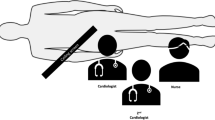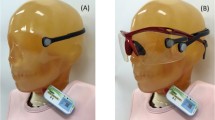Abstract
Considering the increased use of interventional cardiologic procedures and concern about irradiation to the eyes, it is necessary to measure eye dose in radiation workers. The assessment of eye dose using collar dose is a routine but inaccurate method. Therefore this study was designed to measure eye dose in the radiation workers of various interventional cardiologic procedures. In this study eye dose was measured for left and right eyes in three groups of radiation workers in angiography ward of Afshar hospital in various procedures using TLD. Measurements were done separately for cardiologists, nurses and radio-technologists in 100 procedures. The nurses functioned as surgical assistants and were usually close to the table. The correlation of staff dose to exposure parameters was also investigated. Eye dose in physicians were higher than other staff in all procedures. Also the left eye dose was considerably higher than right one, especially for physicians. The median equivalent dose per procedure of left eye for physicians, nurses and radio-technologists were 7.4, 3.6, 1.4 µSv (PCI) and 3.2, 3.1, 1.3 µSv (Adhoc) and 3.2, 1.7, 1.1 µSv (CA), respectively. The annual left eye equivalent dose with (without) using lead goggles were 2.4 (15.3), 1.4 (2.2), 1.0 (1.1) mSv for physicians, nurses and radio-technologists, respectively. There were also a positive correlation between eye dose and KAP for procedures without lead goggles. The lead goggles showed lower protection effects for radio-technologists than other staff. Only 30% of physicians received a dose higher than 1/3 of the ICRP annual dose limit, therefor only physician eye dose should be monitored in catheterization labs.




Similar content being viewed by others
References:s
Efstathopoulos EP, Pantos I, Andreou M, Gkatzis A, Carinou E, Koukorava C et al (2011) Occupational radiation doses to the extremities and the eyes in interventional radiology and cardiology procedures. Br J Radiol 84:70–77
Asgari A, Parach AA, Sharafi AA, Nazarparvar B, Parvizi S (2016) Thyroid, parathyroid and eye dose evaluation in head and neck CT examinations, phantom and clinical study. West Indian Med J. https://doi.org/10.7727/wimj.2015.136
Leyton F, Nogueira MS, Gubolino LA, Pivetta MR, Ubeda C (2016) Correlation between scatter radiation dose at height of operator's eye and dose to patient for different angiographic projections. Appl Radiat Isot 117:100–105
Valentin J (2007) The 2007 Recommendations of the International Commission on Radiological Protection ICRP publication 103. Annals of the ICRP, vol 37. Elsevier, Oxford, pp 1–332
Stewart FA, Akleyev AV, Hauer-Jensen M, Hendry JH, Kleiman NJ, Macvittie TJ et al (2012) ICRP publication 118: ICRP statement on tissue reactions and early and late effects of radiation in normal tissues and organs–threshold doses for tissue reactions in a radiation protection context. Annals of the ICRP, vol 41. Elsevier, Edinburgh, pp 1–322
Farah J, Struelens L, Auvinen A, Jacob S, Koukorava C, Schnelzer M et al (2015) Application of the ELDO approach to assess cumulative eye lens doses for interventional cardiologists. Radiat Prot Dosim 164:84–88
Vano E, Kleiman NJ, Duran A, Romano-Miller M, Rehani MM (2013) Radiation-associated lens opacities in catheterization personnel: results of a survey and direct assessments. J Vasc Interv Radiol 24:197–204
Vano E, Sanchez RM, Fernandez JM (2015) Estimation of staff lens doses during interventional procedures. Comparing cardiology, neuroradiology and interventional radiology. Radiat Prot Dosim 165:279–283
Ainsbury EA, Bouffler SD, Dorr W, Graw J, Muirhead CR, Edwards AA et al (2009) Radiation cataractogenesis: a review of recent studies. Radiat Res 172:1–9
Bitarafan Rajabi A, Noohi F, Hashemi H, Haghjoo M, Miraftab M, Yaghoobi N et al (2015) Ionizing radiation-induced cataract in interventional cardiology staff. Res Cardiovasc Med 4:e25148
Domienik J, Brodecki M (2016) The effectiveness of lead glasses in reducing the doses to eye lenses during cardiac implantation procedures performed using x-ray tubes above the patient table. J Radiol Prot 36:N19–25
O'Connor U, Walsh C, Gallagher A, Dowling A, Guiney M, Ryan JM et al (2015) Occupational radiation dose to eyes from interventional radiology procedures in light of the new eye lens dose limit from the International Commission on Radiological Protection. Br J Radiol 88:20140627
Xiong Z, Vijayan S, Rana V, Jain A, Rudin S, Bednarek DR (2016) Lens of the eye dose calculation for neuro-interventional procedures and CBCT scans of the head. Proc SPIE Int Soc Opt Eng 9783:97832V
Martin CJ (2011) Personal dosimetry for interventional operators: when and how should monitoring be done? Br J Radiol 84:639–648
Geber T, Gunnarsson M, Mattsson S (2011) Eye lens dosimetry for interventional procedures—Relation between the absorbed dose to the lens and dose at measurement positions. Radiat Meas 46:1248–1251
Cemusova Z, Ekendahl D, Judas L (2016) Assessment of eye lens doses in interventional radiology: a simulation in laboratory conditions. Radiat Prot Dosim 170:256–260
Fetterly K, Schueler B, Grams M, Sturchio G, Bell M, Gulati R (2017) Head and neck radiation dose and radiation safety for interventional physicians. JACC Cardiovasc Interv 10:520–528
Fetterly KA, Schueler BA, Grams MP, Sturchio GM (2017) Estimating head and neck tissue dose from x-ray scatter to physicians performing x-ray guided cardiovascular procedures: a phantom study. J Radiol Prot 37:43–58
Antic V, Ciraj-Bjelac O, Rehani M, Aleksandric S, Arandjic D, Ostojic M (2013) Eye lens dosimetry in interventional cardiology: results of staff dose measurements and link to patient dose levels. Radiat Prot Dosim 154:276–284
Shen W, Tang K, Zhu H, Liu B (2002) New Advances in LiF:Mg, Cu, P TLD (GR-200A). Radiat Prot Dosim 100:357–360
Kaljevic J, Ciraj-Bjelac O, Stankovic J, Arandjic D, Bozovic P, Antic V (2016) Occupational dose assessment in interventional cardiology in Serbia. Radiat Prot Dosim 170:279–283
Jacob S, Donadille L, Maccia C, Bar O, Boveda S, Laurier D et al (2013) Eye lens radiation exposure to interventional cardiologists: a retrospective assessment of cumulative doses. Radiat Prot Dosim 153:282–293
Krisanachinda A, Srimahachota S, Matsubara K (2017) The current status of eye lens dose measurement in interventional cardiology personnel in Thailand. Radiol Phys Technol 10:142–147
Wong JHD, Anem LEA, Tan S, Tan SK, Ng KH (2019) Eye lens dose of medical personnel involved in fluoroscopy and interventional procedures at a Malaysian Hospital. Phys Med: Eur J Med Phys 68:47–51
Omar A, Kadesjö N, Palmgren C, Marteinsdottir M, Segerdahl T, Fransson A (2017) Assessment of the occupational eye lens dose for clinical staff in interventional radiology, cardiology and neuroradiology. J Radiol Prot 37:145–159
Magee JS, Martin CJ, Sandblom V, Carter MJ, Almen A, Cederblad A et al (2014) Derivation and application of dose reduction factors for protective eyewear worn in interventional radiology and cardiology. J Radiol Prot 34:811–823
Faroux L, Blanpain T, Fernandez A, Nazeyrollas P, Tassan-Mangina S, Heroguelle V et al (2019) Impact of the table height and the operator's height on the level of radiation delivered to interventional cardiologists. Radiat Prot Dosim. https://doi.org/10.1093/rpd/ncz131
Kollaros N, Carinou E, Plemmenos C, Stathopoulos I, Voudris V, Mastorakou I et al (2014) Eye lens dose measurements in interventional cardiology. Electoronic Presentation online system; ESCR: Scientific Poster
Ciraj-Bjelac O, Rehani MM (2014) Eye dosimetry in interventional radiology and cardiology: current challenges and practical considerations. Radiat Prot Dosim 162:329–337
Principi S, Delgado Soler C, Ginjaume M, Beltran Vilagrasa M, Rovira Escutia JJ, Duch MA (2015) Eye lens dose in interventional cardiology. Radiat Prot Dosim 165:289–293
Principi S (2017) Development of methodologies for estimating the dose to the eye lens in interventional radiology: operational implications of the eye lens new dose limit 2017-09-18.
McLean D, Hadaya D, Tse J (2016) Eye dose to staff involved in interventional and procedural fluoroscopy. IOP Publishing, Bristol, p 012054
Haga Y, Chida K, Kaga Y, Sota M, Meguro T, Zuguchi M (2017) Occupational eye dose in interventional cardiology procedures. Sci Rep 7:569
Ingwersen M, Drabik A, Kulka U, Oestreicher U, Fricke S, Krankenberg H et al (2013) Physicians' radiation exposure in the catheterization lab: does the type of procedure matter? JACC Cardiovasc Interv 6:1095–1102
Jupp T, Kamali-Zonouzi P (2017) Eye lens dosimetry within the cardiac catheterisation laboratory—Are ancillary staff being forgotten? Radiat Prot Dosim 178:1–8
Martin CJ, Magee JS (2013) Assessment of eye and body dose for interventional radiologists, cardiologists, and other interventional staff. J Radiol Prot 33:445–460
Vanhavere F, Carinou E, Gualdrini G, Clairand I, Sans Merce M, Ginjaume M, Nikodemova D, Jankowski J, Bordy J-M, Rimpler A, Wach S, Martin P, Struelens L, Krim S, Koukorava C, Ferrari P, Mariotti F, Fantuzzi E, Donadille L, Itié C, Ruiz N, Carnicer A, Fulop M, Domienik J, Brodecki M, Daures J, Barth I, Bilski P. ORAMED: Optimization of radiation protection of medical staff. 7th EURADOS Report 2012-02. ISSN 2226-8057, ISBN 978-3-943701-01-2
Lie OO, Paulsen GU, Wohni T (2008) Assessment of effective dose and dose to the lens of the eye for the interventional cardiologist. Radiat Prot Dosim 132:313–318
Donadille L, Carinou E, Brodecki M, Domienik J, Jankowski J, Koukorava C et al (2011) Staff eye lens and extremity exposure in interventional cardiology: Results of the ORAMED project. Radiat Meas 46:1203–1209
Rizk C, Farah J, Fares G, Vanhavere F (2018) Occupational doses for the first and second operators in Lebanese Interventional Cardiology Suites. Radiat Prot Dosim 182:438–447
Acknowledgements
We sincerely thank the hospital who provided data for our study. We greatly appreciate the Cath Lab staff in this ward. Without the dedicated support by these professionals this study would not be possible.
Author information
Authors and Affiliations
Contributions
AA: Conceptualization, Methodology, Investigation, Writing- Original draft preparation, Formal analysis AAP: Methodology, Conceptualization, Writing- Reviewing and Editing, Supervision. AHM: Visualization, Writing - Review & Editing, Project administration, Formal analysis. Jan Jansen: Supervision. ZN: Investigation, Resources, Data Curation, Visualization, ED: Investigation, Resources, Data Curation, Visualization, FB: Review & Editing, Methodology, Conceptualization, Formal analysis. SJM: Writing - Review & Editing, Methodology, Conceptualization, Supervision. SMS-H: Methodology, Conceptualization, Investigation, Review & Editing. AA: Investigation, resources, Visualization. JD: Investigation, resources, Visualization, Validation. ME: Investigation, resources, Visualization, Review & Editing.
Corresponding author
Ethics declarations
Conflict of interest
The authors declare that they have no conflict of interest.
Ethical approval
The study was approved by the ethics committee of Shahid Sadoughi University of Medical Sciences. The manuscript does not contain clinical studies or patient data but an informed consent was obtained from each participant.
Additional information
Publisher's Note
Springer Nature remains neutral with regard to jurisdictional claims in published maps and institutional affiliations.
Rights and permissions
About this article
Cite this article
Asgari, A., Parach, A.A., Mirmohammadi, S.J. et al. Occupational eye dose to medical staff in various interventional cardiologic procedures: is the need for lead goggles the same in all groups of radiation workers?. Int J Cardiovasc Imaging 36, 1417–1425 (2020). https://doi.org/10.1007/s10554-020-01864-y
Received:
Accepted:
Published:
Issue Date:
DOI: https://doi.org/10.1007/s10554-020-01864-y




